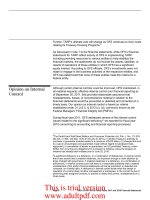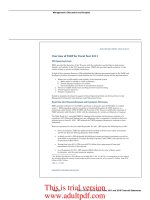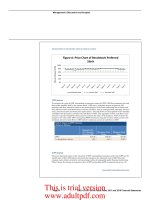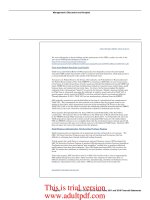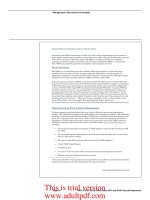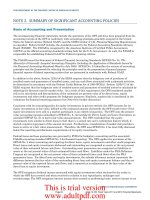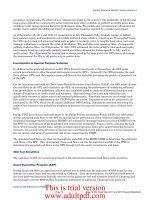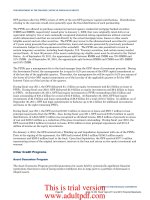United States Government Accountability Office GAO November 2011_part3 pdf
Bạn đang xem bản rút gọn của tài liệu. Xem và tải ngay bản đầy đủ của tài liệu tại đây (314.28 KB, 11 trang )
Management’s Discussion and Analysis
AGENCY FINANCIAL REPORT | FISCAL YEAR 2011
MANAGEMENT‘S DISCUSSION AND ANALYSIS
Overview of TARP for Fiscal Year 2011
OFS Operational Goals
EESA provided the Secretary of the Treasury with the authorities and facilities to help restore
liquidity and stability to the U.S. financial system. EESA also provided specific authority to take
certain actions to prevent avoidable foreclosures.
In light of this statutory direction, OFS established the following operational goals for the TARP and
developed a number of programs to help stabilize the U.S. financial system and the housing market:
1. Ensure the overall stability and liquidity of the financial system.
a. Make capital available to viable institutions.
b. Provide targeted assistance as needed.
c. Increase liquidity and volume in securitization markets.
2. Prevent avoidable foreclosures and help preserve homeownership.
3. Protect taxpayer interests.
4. Promote transparency.
Details on programs developed in support of these Operational Goals can be found later in this
Management’s Discussion and Analysis under Operational Goals.
Fiscal Year 2011 Financial Summary and Cumulative Net Income
EESA provided authority for the TARP to purchase or guarantee up to $700 billion in troubled
assets.
2
EESA spending authority would have terminated December 30, 2009; however, as
authorized under Section 120(b) of EESA, the Secretary of the Treasury certified the extension of
TARP authority until October 3, 2010, with the submission of a written certification to Congress.
The Dodd-Frank Act
3
amended EESA by capping total purchase and guarantee authority at a
cumulative $475 billion and limiting any new obligations only to programs or initiatives that were
initiated prior to June 25, 2010. OFS reduced the TARP program allocations to conform to these
limitations.
Based on operations for the year ended September 30, 2011, OFS reports the following key results:
x Since its inception, TARP has disbursed $413.4 billion in direct loans, equity investments
and for the Treasury Housing Programs Under TARP.
x In fiscal year 2011, OFS disbursed $23.8 billion for loans and equity investments as well as
$1.9 billion in payments for Treasury Housing Programs Under TARP, and reported net cost
of operations of $9.5 billion.
x During fiscal year 2011, OFS received $72.8 billion from repayments of loans and
repurchases and sales of investments.
x As of September 30, 2011, OFS reported $80.8 billion for the value of loans, equity
investments, and the asset guarantee program.
2
The Helping Families Save Their Homes Act of 2009, Pub. L. No. 111-22, Div. A, amended the act and reduced
the maximum allowable amount of outstanding troubled assets under the act by almost $1.3 billion, from $700
billion to $698.7 billion.
3
Pub. L. 111-203.
Page 20 GAO-12-169
OFS's Fiscal Years 2011 and 2010
Financial Statements
This is trial version
www.adultpdf.com
Management’s Discussion and Analysis
THE DEPARTMENT OF THE TREASURY | OFFICE OF FINANCIAL STABILITY
MANAGEMENT‘S DISCUSSION AND ANALYSIS
RResults of TARP Operations (Fiscal Year 2011 and Fiscal Year 2010)
OFS’ fiscal year 2011 net cost of operations of $9.5 billion includes the reported net cost related to
loans, equity investments, and other credit programs. For the fiscal year ended September 30, 2011,
OFS reported net subsidy income for five programs – the Capital Purchase Program (CPP), the
Targeted Investment Program (TIP), the Community Development Capital Initiative (CDCI), the
Term Asset-Backed Securities Loan Facility (TALF), and the Public-Private Investment Program
(PPIP). These programs collectively reported net subsidy income of $4.1 billion. Also, for the fiscal
year ended September 30, 2011, OFS experienced net subsidy cost for four programs – the Asset
Guarantee Program (AGP), the American International Group, Inc. Investment Program, the
Automotive Industry Financing Program (AIFP), and the Federal Housing Agency Refinance
Program totaling $11.3 billion. Fiscal year 2011 expenses for the Treasury Housing Programs Under
TARP of $1.9 billion and administrative expenses of $0.3 billion bring the total reported fiscal year
net cost of operations to $9.5 billion, as shown in Table 1. For the fiscal year ended September 30,
2010, the net income from operations was $23.1 billion as reflected in Table 1. These net income and
net cost amounts reported in the financial statements reflect only transactions through September
30, 2011 and September 30, 2010, respectively, and therefore are different than lifetime cost
estimates made for budgetary purposes.
Page 21 GAO-12-169
OFS's Fiscal Years 2011 and 2010
Financial Statements
This is trial version
www.adultpdf.com
Management’s Discussion and Analysis
AGENCY FINANCIAL REPORT | FISCAL YEAR 2011
MANAGEMENT‘S DISCUSSION AND ANALYSIS
TTable 1: Net Income (Cost) of TARP Operations
(Dollars in billions)
1
TTARP Program
FFor the
YYear Ended
SSeptember
330, 22011
FFor the Year Ended
SSeptember 30, 2010
FFrom TARP’s
IInception through
SSeptember 30, 2011
BBank Support Programs
22
Capital Purchase Program $ 1.8 $ ( 3.9) $ 13.0
Targeted Investment Program 0.2 1.9 4.0
Asset Guarantee Program 1.5 3.7
Community Development Capital
Initiative
3
0.1
(0.3) ( 0.2)
Credit Market Programs
Public-Private Investment Program 1.8 0.7 2.5
Term Asset-Backed Securities Loan
Facility
0.1
3
0.4
SBA 7(a) Securities Purchase
Program
3
Other Programs
Automotive Industry Financing
Program
(9.7) 16.6 (23.6)
American International Group
Investment Program
(1.6) 7.7 (24.3)
FHA-Refinance Program N/A
Total Net Subsidy Income (Cost) (7.33) 24.2 ((24.5))
Additional TARP (Costs)
Treasury Housing Programs Under
TARP (excluding FHA-Refinance
Program)
(1.9) (0.8) (2.7)
Administrative Costs (0.3) (0.3) (0.8)
Total Net Income ((Cost) of TTARP
Operations
$$ (9.5) $ 223.1 $ ((28.0))
1
Information presented in Table 1 is presented in billions of dollars to ensure consistency with other tables in
this Management’s Discussion and Analysis; similar information is presented in the financial statements in
millions of dollars.
2
The Inception through September 30, 2011 column includes dollar amounts related to the $41.6 billion net
cost of operations for the period from inception through September 30, 2009.
3
The Term Asset-Backed Securities Loan Facility, the Community Development Capital Initiative, and the
SBA 7(a) Securities Purchase Program are reported for financial statement purposes under the Consumer and
Business Lending Initiative.
Over time the cost of the TARP programs will change. As described later in the MD&A, and in the
OFS audited financial statements, these estimates are based in part on currently projected economic
factors. These economic factors will likely change, either increasing or decreasing the lifetime cost of
the TARP.
TARP Program Summary
Table 2 provides a financial summary for TARP programs since TARP inception on October 3, 2008,
through September 30, 2011. For each program, the table provides utilized TARP authority (which
includes purchases made, legal commitments to make future purchases, and offsets for guarantees
made), the amount actually disbursed, repayments to OFS from program participants or from sales
Page 22 GAO-12-169
OFS's Fiscal Years 2011 and 2010
Financial Statements
This is trial version
www.adultpdf.com
Management’s Discussion and Analysis
THE DEPARTMENT OF THE TREASURY | OFFICE OF FINANCIAL STABILITY
MANAGEMENT‘S DISCUSSION AND ANALYSIS
of the investments, write-offs and losses, net outstanding balance as of September 30, 2011, and cash
inflows on the investments in the form of dividends, interest or other fees. As of fiscal year end 2011,
$57 billion of the $470 billion in purchase and guarantee authority remained unused.
4
Table 22: TARP Summary
From TARP Inception through September 30, 2011
1
(Dollars in billions)
Purchase
Price or
Guarantee
Amounts
Total $
Disbursed
Investment
Repay-
ments
Write-
offs and
Losses
Out-
standing
Balance
2
Received
from
Invest-
ments
3
Bank Support
Programs
Capital Purchase
Program
4
$ 204.9 $ 204.9 $ (185.0) $ (2.6)
5
$ 17.3 $ 25.7
Targeted Investment
Program 40.0 40.0 (40.0) - - 4.4
Asset Guarantee
Program 5.0 - - - - 3.0
Community
Development Capital
Initiative 0.6
6
0.6 - - 0.6 -
Credit Market
PPrograms
Public Private
Investment Program 21.9 17.6 (1.7) - 15.9 0.7
Term Asset-Backed
Securities Loan
Facility
6
4.3 0.1 - - 0.1 -
SBA 7(a) Securities
Purchase Program 0.3
6
0.3 (0.2) - 0.1 -
Other Programs
Automotive Industry
Financing Program 79.7 79.7 (35.0) (7.4) 37.3 5.0
American
International Group
Investment Program 67.8 67.8 (15.0) (1.9) 51.1 0.4
Sub total for
Investment Programs 424.5 411.0 (276.9) (11.9) 122.4 39.2
Treasury Housing
Programs Under
TARP
45.6 2.4
7
N/A N/A N/A N/A
Total for TARP
Program $ 4470.1 $ 4413 4
$ ((276.9) $ ((11.9) $ 1122.4 $ 339.2
4
OFS tracks costs in accordance with Federal budget procedures. First, OFS enters into legally binding
“obligations” to invest or spend the funds for TARP programs. Then, funds are disbursed over time pursuant to
the obligations. In any given case, it is possible that the full amount obligated will not be disbursed.
Page 23 GAO-12-169
OFS's Fiscal Years 2011 and 2010
Financial Statements
This is trial version
www.adultpdf.com
Management’s Discussion and Analysis
AGENCY FINANCIAL REPORT | FISCAL YEAR 2011
MANAGEMENT‘S DISCUSSION AND ANALYSIS
1
This table shows the TARP activity for the period from inception through September 30, 2011, on a cash basis.
Received from investments includes dividends and interest income reported in the Statement of Net Cost, and
Proceeds from sale and repurchases of assets in excess of costs.
2
Losses represent proceeds less than cost on sales of assets which are reflected in the financial statements
within “net proceeds from sales and repurchases of assets in excess of (less than) cost”.
3
Total disbursements less repayments, writeoffs and losses do not equal the total outstanding balance
primarily because the disbursements for the Treasury Housing Programs Under TARP generally do not require
(and OFS does not expect) repayments, and because of certain capitalized income relating to the AIG
Investment Program.
4
OFS received $31.9 billion in proceeds from sales of Citigroup common stock, of which $25 billion is included
at cost in investment repayments, and $6.9 billion of net proceeds in excess of cost is included in Received from
Investments.
5
Includes $2.2 billion of SBLF refinancing outside of TARP and CDCI exchanges from CPP of $363 million.
6
The Term Asset-Backed Securities Loan Facility, the Community Development Capital Initiative, and the
SBA 7(a) Securities Purchase Program are reported for financial statement purposes under the Consumer and
Business Lending Initiative.
7
Individual obligation amounts are $29.9 billion for the Making Home Affordable Program, $7.6 billion for the
Hardest Hit Fund, and $8.1 billion committed for the FHA-Refinance Program.
Most of the TARP funds have been used to make investments in preferred stock or to make loans.
OFS has generally received dividends on the preferred stock and interest payments on the loans
from the institutions participating in TARP programs. These payments represent a return on OFS’
TARP investments. From inception through September 30, 2011, OFS received a total of $20.4
billion in dividends, interest and fees. Table 3 shows the breakdown of receipts for the periods ended
September 30, 2011 and 2010 for all TARP programs combined as well as totals for the period from
inception through September 30, 2011.
TTable 3: TARP Receipts and Repayments
oon Investments/Loans
(Dollars in billions)
1
For the Year
Ended September
30, 2011
For the Year
Ended September
30, 2010
From TARP’s
inception through
September 30,
2011
Dividends, IInterest, Fees and
Warrant Repurchases
2
Dividends and Fees $ 2.8 $ 5.9 $ 18.3
Interest 0.9 1.0 2.1
Sales/Repurchases of Warrants and
Warrant Preferred Stock and
Additional Notes
1.5
5.2
9.6
Proceeds from Sales of Citigroup
Common Stock in Excess of Cost
3.9
3.0
6.9
Other Proceeds in Excess of Cost 2.3 2.3
Subtotal 11.4 15.1 39.2
Investment/Loan Repayments
Sales/Repurchases/Repayments on
Investments 66.5
3
122.0 259.2
Loan Principal Repaid 6.3 9.3 17.7
Subtotal 72.8 131.3 276.9
GRAND TOTAL $ 84.2 $ 146.4 $ 316.1
Page 24 GAO-12-169
OFS's Fiscal Years 2011 and 2010
Financial Statements
This is trial version
www.adultpdf.com
Management’s Discussion and Analysis
THE DEPARTMENT OF THE TREASURY | OFFICE OF FINANCIAL STABILITY
MANAGEMENT‘S DISCUSSION AND ANALYSIS
1
This table shows TARP activity on a cash basis.
2
The total reported for the Inception through September 30, 2011 column includes the $85.5 billion in receipts
and repayments related to the period from inception through September 30, 2009.
3
Includes $2.2 billion of SBLF refinancing outside of TARP and CDCI exchanges from CPP of $363 million.
OFS also received warrants in connection with most of its investments, which provides an
opportunity for taxpayers to realize an upside on investments. Since the program’s inception, OFS
has received $9.1 billion in gross proceeds from the disposition of warrants associated with 93 CPP
investments and both TIP investments, consisting of (i) $3.7 billion from issuer repurchases at
agreed upon values and (ii) $5.4 billion from auctions. TARP’s Warrant Disposition Report is posted
on the OFS website at the following link:
/>.
Summary of TARP Direct Loans and Equity Investments
Table 4 provides information on the estimated values of the TARP direct loan and equity
investments by program, as of the end of fiscal years 2011 and 2010. (Treasury Housing Programs
Under TARP are excluded from the chart because no repayments are required). The Outstanding
Balance column represents the amounts disbursed by OFS relating to the loans and equity
investments that were outstanding as of September 30, 2011 and 2010. The Estimated Value of the
Investment column represents the present value of net cash inflows that OFS estimates it will
receive from the loans and equity investments. For equity securities, this amount represents fair
value. The total difference of $42.3 billion (2011) and $36.8 billion (2010) between the two columns
is considered the “subsidy cost allowance” under the Federal Credit Reform Act methods OFS follows
for budget and accounting purposes (see Note 6 in the financial statements for further discussion).
5
Table 4: Summary of TARP Direct Loans and Equity Investments
(Dollars in billions)
Program
Outstanding
Balance as of
September
30, 2011
Estimated
Value of
Investment
1
as of
September
30, 2011
Outstanding
Balance as of
September
30, 2010
Estimated
Value of
Investment
1
as of September
30, 2010
Bank Support Programs
Capital Purchase Program
$ 17.3 $ 12.4 $ 49.8 $ 48.2
Community Development Capital
Initiative
0.6
2
0.4 0.6 0.4
Credit Market Programs
Public-Private Investment
Program
15.9 18.4 13.7 14.4
Term Asset-Backed Securities
Loan Facility
0.1
2
0.6 0.1 0.4
SBA 7(a) Securities Purchase
Program
0.1
2
0.1 0.2 0.2
5
The subsidy cost in Table 1 and on the Statement of Net Cost, is composed of (1) the change in the subsidy
cost allowance, net of write-offs, (2) net intragovernmental interest cost, (3) certain inflows from the direct loans
and equity investments (e.g., dividends, interest, net proceeds from sales and repurchases of assets in excess of
cost, and other realized fees), and (4) the change in the estimated discounted net cash flows related to the asset
guarantee program and FHA-Refinance Program.
Page 25 GAO-12-169
OFS's Fiscal Years 2011 and 2010
Financial Statements
This is trial version
www.adultpdf.com
Management’s Discussion and Analysis
AGENCY FINANCIAL REPORT | FISCAL YEAR 2011
MANAGEMENT‘S DISCUSSION AND ANALYSIS
OOther Programs
Automotive Industry Financing
Program
37.3 17.8 67.2 52.7
American International Group
Investment Program
51.1 30.4 47.6 26.1
TTotal
$$ 122.4 $$ 80.1 $$ 179.2 $$ 1142.4
1
Before subsidy cost allowance.
2
The Term Asset-Backed Securities Loan Facility, the Community Development Capital Initiative,
and the SBA 7(a) Securities Purchase Program are reported for financial statement purposes
under the Consumer and Business Lending Initiative.
The ultimate cost of the TARP will not be known for some time. The financial performance of the
programs will depend on many factors such as future economic and financial conditions, and the
business prospects of specific institutions. The cost estimates are sensitive to slight changes in
model assumptions, such as general economic conditions, specific stock price volatility of the entities
in which OFS has an equity interest, estimates of expected defaults, and prepayments. If OFS
receives repayments faster than expected and incurs lower than expected defaults, TARP’s ultimate
cost on these investments may be lower than estimated. Wherever possible, OFS uses market prices
of tradable securities to estimate the fair value of TARP investments. Use of market prices was
possible for TARP investments that trade in public markets or are closely related to tradable
securities. For those TARP investments that do not have direct analogs in private markets, OFS uses
internal market-based models to estimate the market value of these investments. All cash flows are
adjusted for market risk. Further details on asset valuation can be found in Note 6 of the Financial
Statements.
Comparison of Estimated Lifetime TARP Costs Over Time
Market conditions and the performance of specific financial institutions will be critical determinants
of the TARP’s lifetime cost. The changes in the OFS estimates since TARP’s inception through
September 30, 2011, provide a good illustration of this impact. Table 5 provides information on how
OFS’ estimated lifetime cost of TARP has changed over time. These costs fluctuate in large part due
to changes in the market prices of common stock for AIG and GM and the estimated value of the Ally
stock. This table assumes that all expected investments (e.g. PPIP) and disbursements for Treasury
Housing Programs Under TARP are completed, and adhere to government budgeting guidance. This
table will not tie to the financial statements since it includes investments and other disbursements
expected to be made in the future. Table 5 is consistent with the estimated lifetime cost disclosures
on the TARP web site at:
www.financialstability.gov
. The cost amounts in Table 5 are based on
assumptions regarding future events, which are inherently uncertain.
Page 26 GAO-12-169
OFS's Fiscal Years 2011 and 2010
Financial Statements
This is trial version
www.adultpdf.com
Management’s Discussion and Analysis
THE DEPARTMENT OF THE TREASURY | OFFICE OF FINANCIAL STABILITY
MANAGEMENT‘S DISCUSSION AND ANALYSIS
TTable 5: Estimated Lifetime TARP Costs (Income)
(Dollars in billions)
11
PProgram
EEstimated
LLifetime Cost
((Income) on
MMarch 31, 2010
EEstimated
LLifetime Cost
((Income) on
SSeptember 30,
22010
EEstimated
LLifetime Cost
((Income) on
MMarch 31,
22011
EEstimated
LLifetime Cost
((Income) on
SSeptember 30,
22011
BBank Support Programs
Capital Purchase Program $ ( 9.8) $ (11.2) $ (13.6) $ (13.0)
Targeted Investment Program ( 3.8) ( 3.8) ( 4.0) ( 4.0)
Asset Guarantee Program ( 3.1)
2
( 3.7) ( 3.8) ( 3.7)
Community Development Capital
Initiative
0.4
3
0.3 0.2 0.2
CCredit Market Programs
Public Private Investment
Program
0.5 ( 0.7) 0.4 ( 2.4)
Term Asset-Backed Securities
Loan Facility
( 0.4)
3
( 0.4) ( 0.3) ( 0.4)
SBA 7(a) Securities Purchase
Program
3
0.0
0.0 0.0 ( 0.0)
Other Consumer Business
Lending Initiative
3.0 N/A N/A N/A
OOther Programs
Automotive Industry Financing
Program
24.6 14.7 13.9 23.6
American International Group
Investment Program
45.2 36.9 10.9 24.3
SSubtotal 56.6 32.1 3.7 24.5
Treasury Housing Programs
Under TARP
48.8
4
45.6 45.6 45.6
TTotal
$$ 105.4 $$ 77.7 $$ 449.3 $$ 70.2
1
Estimated program costs (+) or savings (in parentheses) over the life of the program, including interest on re-
estimates and excluding administrative costs.
2
Prior to the termination of the guarantee agreement, Treasury guaranteed up to $5 billion of potential losses on a
$301 billion portfolio of loans.
3
The Term Asset-Backed Securities Loan Facility, the Community Development Capital Initiative and the SBA 7(a)
Securities Purchase Program are reported for financial statement purposes under the Consumer and Business
Lending Initiative.
4
Key Trends/Factors Affecting TARP Future Activities and
Ultimate Cost
For fiscal year 2011, includes FHA-Refinance Program which is accounted for under credit reform.
This section provides additional TARP analytic information and enhanced sensitivity analysis
focusing on the remaining TARP dollars/continued taxpayer exposure and what is likely to affect the
expected future return. Four TARP programs CPP, PPIP, AIFP, and the AIG Investment Program
have $10 billion or more still outstanding and remain at risk of taxpayer loss. In addition,
Page 27 GAO-12-169
OFS's Fiscal Years 2011 and 2010
Financial Statements
This is trial version
www.adultpdf.com
Management’s Discussion and Analysis
AGENCY FINANCIAL REPORT | FISCAL YEAR 2011
MANAGEMENT‘S DISCUSSION AND ANALYSIS
Treasury’s Housing Programs Under TARP have about $43 billion committed but not yet disbursed.
Going forward, the recoveries or costs from CPP, PPIP, AIFP, and AIG Investment Program and the
expenditures for Treasury Housing Programs Under TARP will most significantly affect the lifetime
cost of the TARP.
CPP and Banking Industry Information
OFS had CPP investments remaining in 401 financial institutions with a gross outstanding balance
of $17.3 billion as of September 30, 2011. As noted earlier in this report, the largest financial
institutions in the CPP have repaid their investments to OFS.
Table 6 below shows the outstanding investment face amount for the 10 largest remaining CPP
investments held as of September 30, 2011.
Table 6: 110 Largest Remaining CPP Investments
(Dollars in billions)
Institution Outstanding Investment
Regions Financial Corporation $ 3.500
Zions Bancorporation 1.400
Synovus Financial Corp. 0.968
Popular, Inc. 0.935
First Bancorp. 0.424
M&T Bank Corporation 0.382
Sterling Financial Corporation 0.303
Citizens Republic Bancorp, Inc. 0.300
First Banks, Inc. 0.295
New York Private Bank & Trust Corporation 0.267
Total $ 8.774
OFS’ actual recoveries on the outstanding CPP investments will depend on a number of factors,
including the asset quality, loss reserve ratios and capital positions of financial institutions
participating in CPP.
Throughout the life of the program, 181 CPP recipients have not declared and paid one or more
dividends to OFS. Of these recipients, 74 have missed at least six payments, which gives OFS the
right to place members on the institutions’ boards of directors. During fiscal year 2011, OFS
exercised its rights to elect 10 members in total to boards of directors for 6 CPP institutions. Board
members elected by OFS cannot be government employees and all have the same fiduciary duties
and obligations to the shareholders of the financial institutions as any other board members.
Additional information on the appointment of directors to CPP institutions is available at:
/>.
Since the initiation of the CPP, 13 institutions in which OFS had invested $2.9 billion have entered
bankruptcy or been placed in receivership by their regulators. This includes eight CPP recipients
($190.3 million in funding) during fiscal year 2011; and five CPP recipients ($2.7 billion in funding)
during fiscal year 2010. During fiscal year 2010 OFS wrote-off $2.3 billion relating to CIT Group
and another small institution, and made no CPP investment write-offs in fiscal year 2011. As OFS
does not anticipate any recovery from the other 11 investments outstanding relating to institutions
that entered bankruptcy or receivership, the value of these investments is reflected at zero as of
September 30, 2011.
Page 28 GAO-12-169
OFS's Fiscal Years 2011 and 2010
Financial Statements
This is trial version
www.adultpdf.com
Management’s Discussion and Analysis
THE DEPARTMENT OF THE TREASURY | OFFICE OF FINANCIAL STABILITY
MANAGEMENT‘S DISCUSSION AND ANALYSIS
Public-Private Investment Program
As of September 30, 2011, OFS had gross outstanding equity investments in and loans to Public
Private Investment Funds (PPIFs) amounting to $5.5 billion and $10.4 billion, respectively, for a
total of $15.9 billion. In addition, as of September 30, 2011, OFS had legal commitments to disburse
up to $4.3 billion in additional funds to the PPIFs. The estimated value of OFS’s investments and
loans in the PPIFs as of September 30, 2011, was approximately $18.4 billion. PPIFs have the
ability to invest in eligible assets over a three-year investment period. They then have up to five
additional years, which may be extended for up to two more years, to manage these investments and
return the profits to OFS and the other PPIF investors. In addition, OFS also received warrants
from the PPIFs, which gives OFS the right to receive a percentage of the profits that would
otherwise be distributed to the private partners that are in excess of their contributed capital. The
PPIFs are now more than halfway through their three-year investment periods, which end in the
fourth quarter of fiscal year 2012.
Automotive Industry Financing Program
As of September 30, 2011, OFS held $37.3 billion in AIFP investments, with an estimated value of
$17.8 billion. As of September 30, 2011, OFS has received more than $40 billion from repayments,
sales, dividends, interest, and other income. The competitiveness of U.S. manufacturers, both
domestically and internationally will affect the value of OFS’ investment. In addition, the
macroeconomic conditions (unemployment, Gross Domestic Product growth, etc.) will affect the
overall trends in auto sales and thus OFS’ recoveries.
The outlook for the American auto industry has improved significantly, thanks in part to the
emergency assistance provided by the federal government. Detroit’s Big Three have all reported
profits and gains in market share for the first time since 1995.
General Motors Company (New GM), reported second quarter net income of $2.5 billion, its sixth
consecutive profitable quarter. Since emerging from bankruptcy, the company has added shifts at
six of its plants to address growing demand. New Chrysler has also significantly rebounded after its
bankruptcy filing. The company has lowered its structural costs, become more efficient, adopted new
technologies, rejuvenated its product line, and rebuilt its brand value.
AIG
Investment Program
Following the government’s emergency assistance to AIG, the company is now experiencing a
turnaroun
d. AIG has completed a successful restructuring, stabilized its operations, and as a result,
OFS is in a considerably stronger position to exit OFS’ investment in AIG than was thought possible
during the height of the 2008 financial crisis.
As of September 30, 2011, OFS held $51.1 billion in the AIG Investment Program, with an estimated
value of $30.4 billion. As of September 30, 2011, OFS had received $15.4 billion from repayments
and sales, dividends and other income. OFS’ investment in AIG was originally made in the form of
preferred stock, all of which was converted to common stock or preferred interests in AIG Special
Purpose Vehicles in the restructuring that took place in January 2011.
Treasury Housing Programs Under TARP
OFS has committed $45.6 billion to fund Treasury Housing Programs Under TARP. From inception
through September 30, 2011, $2.4 billion has been disbursed under these programs. Based only on
the permanent modifications in place as of September 30, 2011, OFS estimates that $7.6 billion in
Page 29 GAO-12-169
OFS's Fiscal Years 2011 and 2010
Financial Statements
This is trial version
www.adultpdf.com
Management’s Discussion and Analysis
AGENCY FINANCIAL REPORT | FISCAL YEAR 2011
MANAGEMENT‘S DISCUSSION AND ANALYSIS
incentive fees will ultimately be disbursed in association with all Making Home Affordable (MHA)
modifications made as of September 30, 2011, if all active modifications were to remain current and
receive incentives for 5 years. The program is continuing to enter into new modifications.
Separately, $7.6 billion has been allocated for the Hardest Hit Fund and $8.1 billion for the FHA
Refinance Program.
SSensitivity Analysis
The ultimate value of TARP investments will only be known in time. Realized values will vary from
current estimates in part because economic and financial conditions will change. Many TARP
investments do not have readily observable values and their values can only be estimated by OFS.
Sensitivity analysis is one way to get some feel for the degree of uncertainty around the OFS
estimates. In the analysis reported here, OFS focuses on the largest components of the TARP, the
assets held under CPP, PPIP, AIFP and the AIG Investment Program.
CPP Analysis
For CPP, the most important inputs to the valuation are the market prices of publicly-traded
preferred stock used to calibrate the model-derived pricing of the preferred stock held in the TARP.
The valuation procedure entails observing the market price of publicly-traded preferred stock and
calibrating the model (in particular the risk premium) to match those prices. The calibrated model is
then used to price the non-publicly traded preferred stock held by the TARP. The benchmark
preferred stock consists of a portfolio of claims issued by some of the same institutions with TARP
preferred stock investments. It is generally the larger institutions that have issued preferred stock.
The TARP preferred stock for smaller institutions may not be exactly comparable, but the bulk of
TARP investments, as measured on a dollar basis, are in the larger institutions. This calibration
influences the asset-to-liability ratio of the banks and consequently the default and prepayment
estimates predicted by the model.
6
Table 7: Impact on CPP Valuation
As a sensitivity analysis, OFS increased and decreased the value
of the be
nchmark preferred stock in the CPP by 10 percent. Table 7 shows the impact on the value
of OFS’ outstanding investment in CPP as a result of a 10 percent increase and a 10 percent
decrease in the value of the calibration securities.
(Dollars in Billions)
September 30,
2011 Reported
Value for CPP
Effect of 10%
Increase
Effect of 10%
Decrease
CPP $12.44 $12.99 $11.19
% change from current N/A 4.4% (10.1)%
To put this sensitivity analysis in perspective, it is useful to consider the range over which actual
securities have moved over the past year. Figure A shows the monthly average price of the
benchmark preferred as a percentage of par. (The CPP value as of September 30, 2011, represents
approximately 74.6 percent of par, excluding the warrants held by OFS). The dashed lines indicate
the upper and lower bound price used for the sensitivity analysis.
6
See discussion of valuation methodology in Note 6 of the Financial Statements.
Page 30 GAO-12-169
OFS's Fiscal Years 2011 and 2010
Financial Statements
This is trial version
www.adultpdf.com

